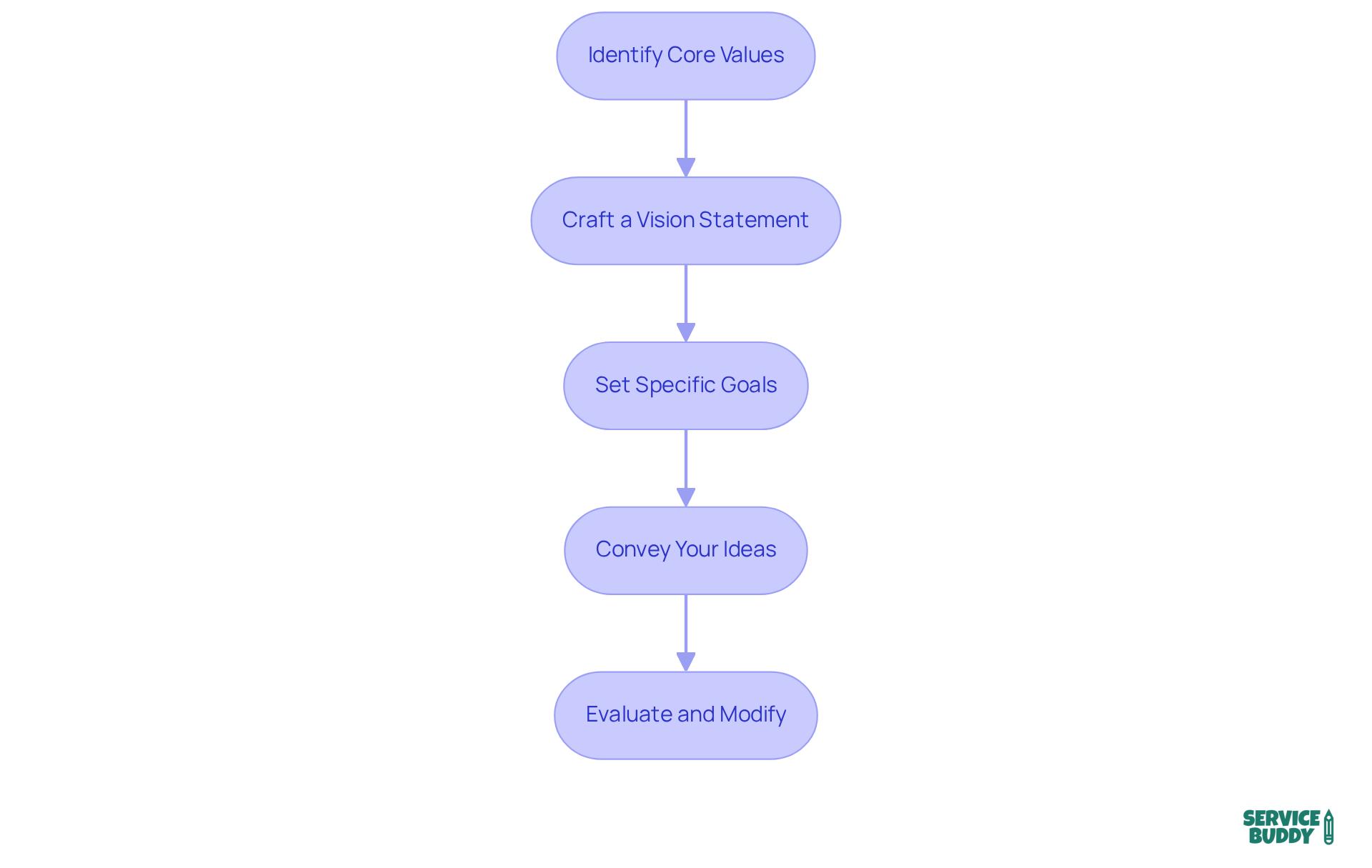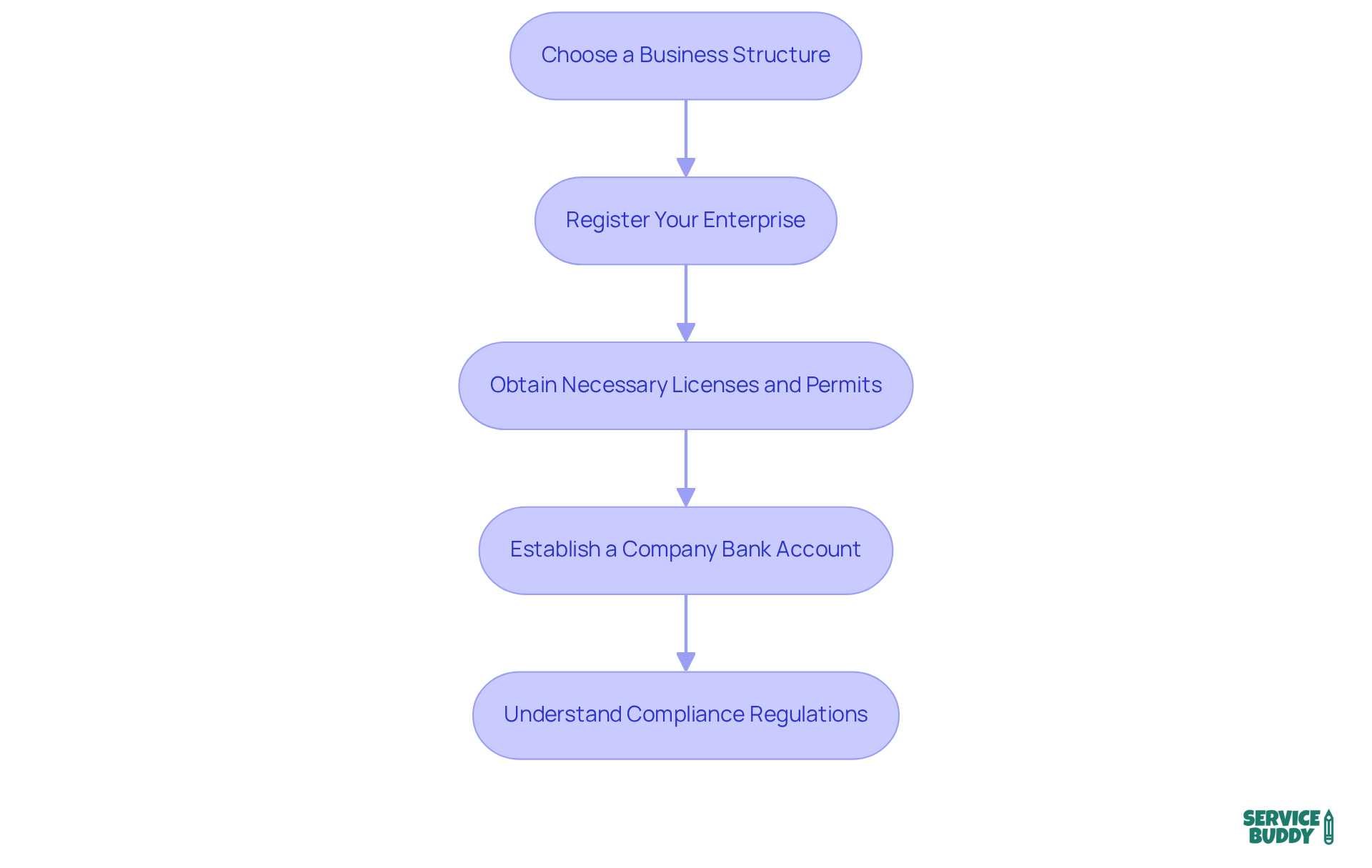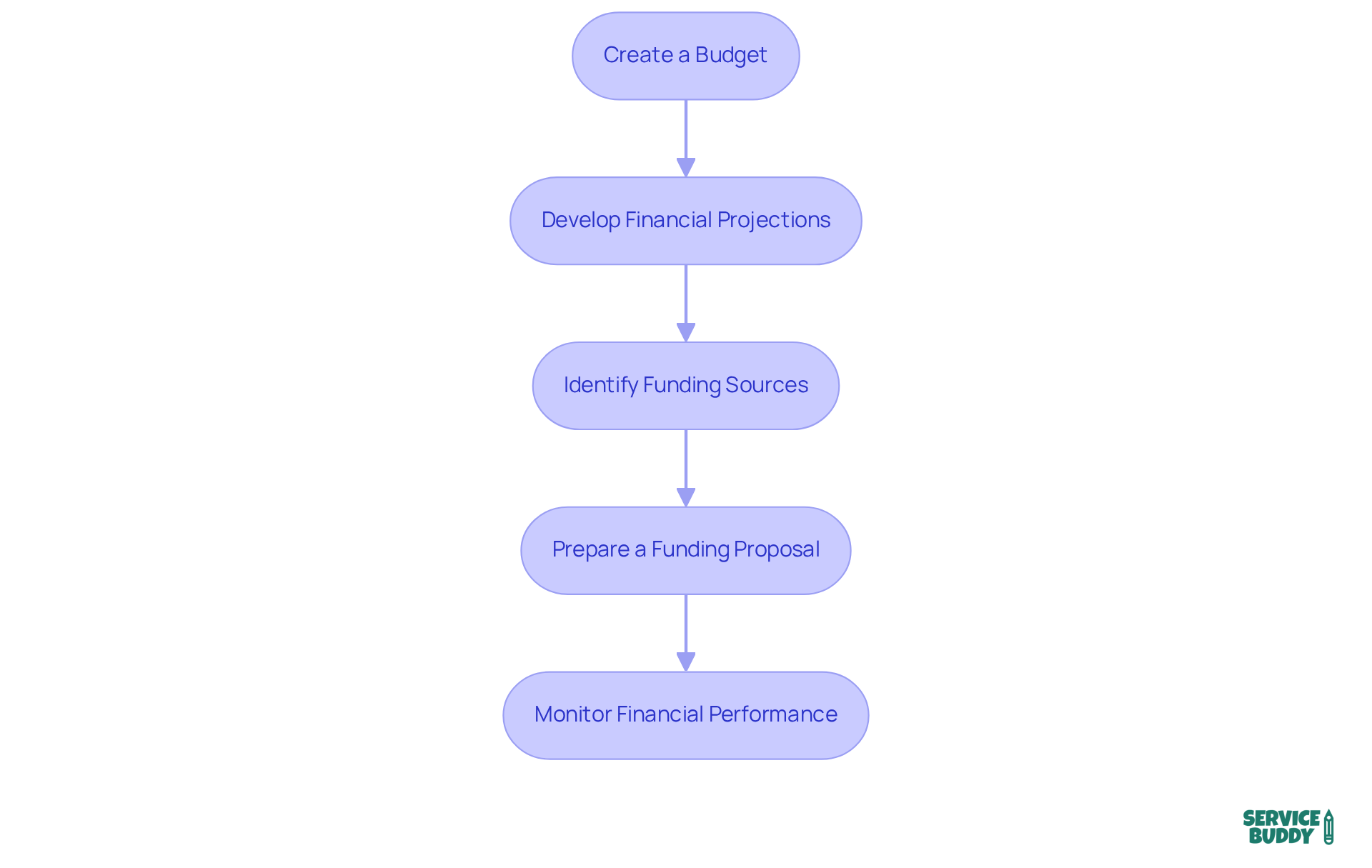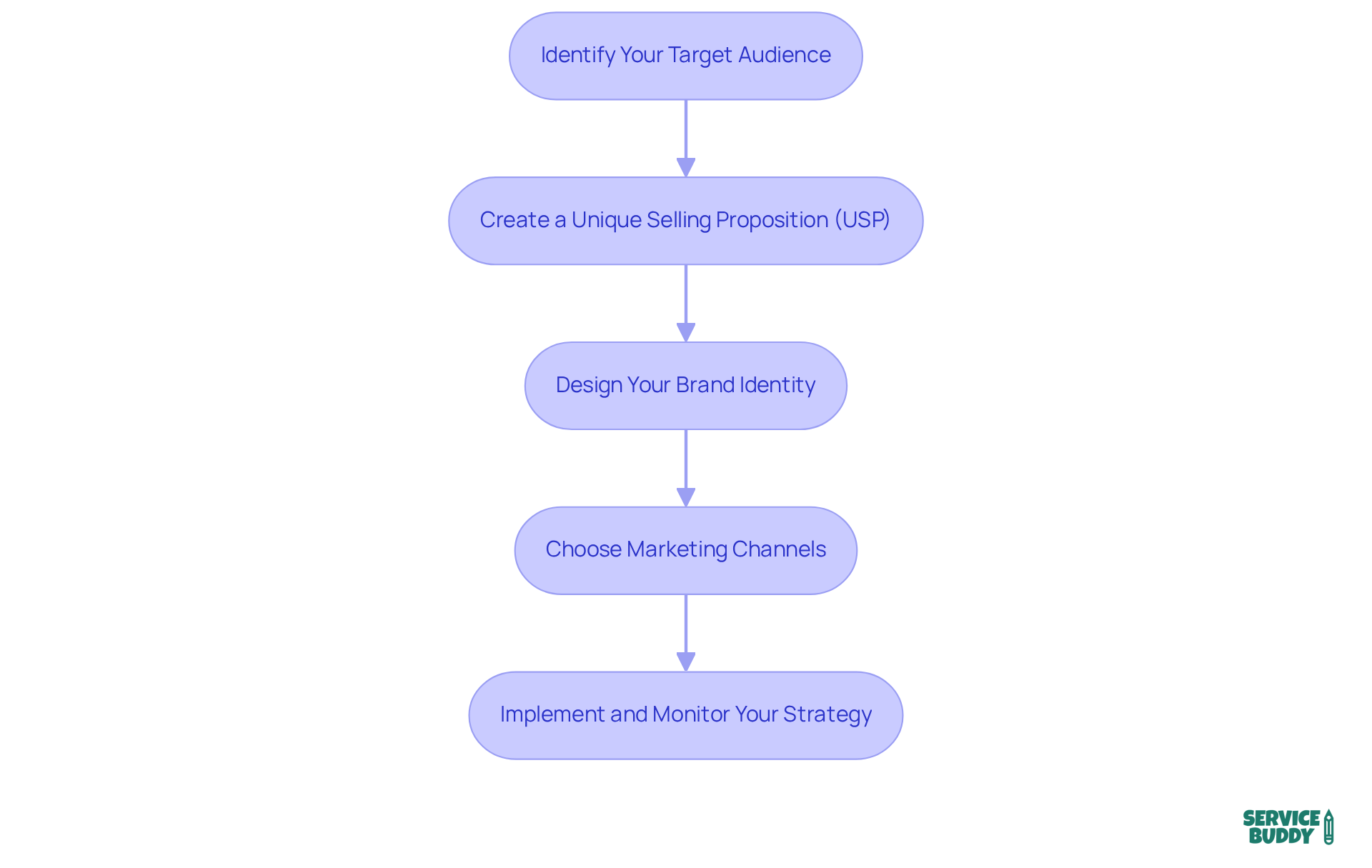Overview
This article outlines five essential steps for effectively creating a flooring business plan. These steps include:
- Defining the business vision
- Establishing legal compliance
- Outlining financial projections
- Developing a marketing strategy
- Implementing operational systems
Each step is supported by specific actions and considerations, ensuring the business is well-prepared for success in a competitive market.
Understanding the importance of a solid foundation and strategic planning is crucial. By clearly defining your business vision, you set the stage for your operational strategies. Legal compliance is not just a requirement; it protects your business and builds trust with your customers. Financial projections provide a roadmap for your growth, while a robust marketing strategy ensures that your services reach the right audience. Finally, operational systems are the backbone of your business, facilitating smooth day-to-day operations.
In summary, these steps create a comprehensive framework for flooring business owners to navigate their operational challenges confidently. Emphasizing the importance of each component will help you establish a successful flooring business.
Introduction
Crafting a successful flooring business plan is not just a step; it is a critical leap for entrepreneurs aiming to thrive in the competitive landscape of this expanding industry. By clearly defining a vision, establishing a solid legal framework, and outlining robust financial strategies, business owners can effectively set the stage for sustainable growth. Yet, the journey is fraught with challenges—how can one ensure that every facet of the plan aligns with market demands and operational realities? This guide will delve into five essential steps to create an effective flooring business plan, empowering entrepreneurs to transform their aspirations into actionable strategies.
Define Your Flooring Business Vision and Goals
To define your flooring business vision and goals, follow these steps:
-
Identify Your Core Values: Reflect on the principles that matter most to you and your business, such as quality, customer service, sustainability, or innovation. These values will serve as the foundation for your aspirations.
-
Craft a Vision Statement: Develop a concise statement that captures your long-term aspirations. For example, "To be the leading provider of eco-friendly flooring solutions in our region." A well-crafted purpose statement should ideally be no longer than a sentence or two, ensuring it is memorable and easily communicated throughout your organization.
-
Set Specific Goals: Convert your aspirations into actionable objectives using the SMART criteria—specific, measurable, achievable, relevant, and time-bound. For instance, aim to increase sales by 20% within the next year or expand your service area by two new cities.
-
Convey Your Ideas: Share your ideas and goals with your team to foster alignment and motivation. Involving employees in this process can strengthen their dedication and drive toward achieving organizational goals. Additionally, consider engaging with stakeholders to gather insights that can guide your statement, ensuring it resonates with the entire organization.
-
Evaluate and Modify: Regularly reassess your objectives and aspirations to ensure they remain relevant as your enterprise evolves. This adaptability is crucial in a dynamic market, allowing you to respond effectively to changes and seize new opportunities.
A powerful mission statement not only directs your company strategy but also inspires your team and builds trust with clients. Companies that prioritize a clear vision are better positioned to navigate challenges and capitalize on growth opportunities.

Establish Legal Structure and Compliance Requirements
To establish your flooring business's legal structure and compliance requirements, follow these essential steps:
-
Choose a Business Structure: Decide whether to operate as a sole proprietorship, partnership, limited liability company (LLC), or corporation. Each structure carries distinct implications for liability, taxation, and management. For instance, an LLC provides personal asset protection while allowing profits to be taxed as individual income, which can be advantageous for small enterprise owners. As Jennifer Friedman highlights, states have varying requirements for different organizational structures, making it crucial to comprehend these nuances.
-
Register Your Enterprise: File the necessary paperwork with your state or local government to officially register your name and structure. This step is vital for legitimizing your operations and ensuring compliance with state regulations.
-
Obtain Necessary Licenses and Permits: Research and apply for any required licenses or permits specific to the sector, such as contractor licenses or sales tax permits. Compliance requirements can vary significantly by state, so it’s essential to understand the specific regulations that apply to your location.
-
Establish a Company Bank Account: Open a separate bank account for your enterprise to maintain a clear distinction between personal and corporate finances. This practice simplifies accounting and tax filing while enhancing professionalism when dealing with clients and suppliers. As emphasized in the case analysis on the significance of a corporate bank account for LLCs in the industry, preserving this differentiation is crucial for ensuring adherence to the liability protections provided by an LLC framework.
-
Understand Compliance Regulations: Familiarize yourself with local, state, and federal regulations that pertain to your trade, including safety standards and employment laws. Engaging with regulatory authorities can facilitate a smoother compliance process, ensuring that your installations meet all necessary requirements. For example, understanding the Americans with Disabilities Act (ADA) is vital for creating inclusive spaces in commercial projects.
By following these steps, you can establish a strong foundation for your enterprise, ensuring it operates within legal parameters while positioning itself for growth and success. With the market for floor coverings projected to grow from USD 439.27 billion in 2025 to USD 646.70 billion by 2032, establishing a solid legal foundation is more important than ever.

Outline Financial Projections and Funding Strategies
To effectively outline your financial projections and funding strategies, consider the following steps:
-
Create a Budget: Begin by estimating your startup costs, which should encompass equipment, inventory, marketing, and operational expenses. This comprehensive budget will clarify the capital required to successfully launch your flooring business plan.
-
Develop Financial Projections: Construct detailed financial projections for at least the first three years of operation. This should include income statements, cash flow statements, and balance sheets. Leveraging historical data from comparable enterprises can offer valuable insights and improve the precision of your forecasts. Consistently monitoring revenue and expenses is essential to assess if your company generates sufficient income to cover costs.
-
Identify Funding Sources: Investigate a variety of funding options, including personal savings, bank loans, investors, and grants. Each source has its pros and cons; for example, while traditional loans may necessitate collateral, unsecured loans provide a risk-free option for new enterprises. Funding amounts can range from $25,000 to $500,000, depending on your needs and the funding source.
-
Prepare a Funding Proposal: If you intend to pursue external financing, create an engaging proposal that clearly details your project plan, financial forecasts, and the intended application of the funds. A well-structured proposal can significantly increase your chances of securing the necessary capital.
-
Monitor Financial Performance: After starting your venture, it is essential to regularly assess your financial performance against your projections. This ongoing assessment will enable you to make informed adjustments and ensure your business remains on track for growth. Adhering to budgets and issuing accurate invoices are essential practices that contribute to effective financial management.
By following these steps, business entrepreneurs can establish a solid financial foundation, which is essential for a flooring business plan that paves the way for sustainable growth and success in a competitive market.

Develop a Marketing Strategy and Brand Identity
To effectively develop your marketing strategy and brand identity, consider the following steps:
-
Identify Your Target Audience: Conduct thorough research to define your ideal clients based on demographics, preferences, and purchasing behaviors. Understanding your audience is crucial for tailoring your marketing efforts and ensuring they resonate with potential clients.
-
Create a Unique Selling Proposition (USP): Identify what differentiates your flooring business plan from competitors. This could encompass outstanding client support, eco-friendly products, or competitive pricing. A strong USP not only draws in clients but also enhances the effectiveness of your flooring business plan in the marketplace, particularly as sustainability becomes a priority for many consumers.
-
Design Your Brand Identity: Craft a cohesive brand identity that includes a logo, color scheme, and overall aesthetic reflecting your brand's values. Branding experts state that while digital platforms have changed how brands are built and perceived, they have not diminished the importance of a strong brand identity and reputation. Consistency in branding across all platforms enhances recognition and builds trust with your audience.
-
Choose Marketing Channels: Select the most effective marketing channels to reach your audience, such as social media, email marketing, or local advertising. Utilizing social media platforms for promotions can significantly enhance your reach. Tailor your messaging for each channel to maximize engagement and conversion rates. Furthermore, participating in community events can improve your company's visibility, facilitating direct connections with prospective clients.
-
Implement and Monitor Your Strategy: Launch your marketing campaigns and closely track their performance. Utilize analytics to measure success and make necessary adjustments to improve results. Continuous monitoring allows you to stay agile and responsive to market changes. Displaying project images or client testimonials on your site can also aid in establishing credibility and attracting new customers.

Implement Operational Systems and Management Tools
To implement operational systems and management tools effectively, follow these essential steps:
-
Assess Your Needs: Begin by identifying the specific operational challenges your business faces. Are you struggling with job scheduling, inventory management, or client communication? Understanding these issues is crucial for selecting the right tools.
-
Research Management Tools: Explore software solutions tailored specifically for your flooring business plan. Look into project management tools, CRM systems, and accounting software. Focus on features that align with your identified needs to ensure a good fit.
-
Integrate Systems: Select tools that can seamlessly integrate with one another to streamline your processes. For instance, a CRM that connects with your accounting software can simplify invoicing and enhance customer management.
-
Train Your Team: It is vital to ensure that your staff is well-trained in using the new systems effectively. Provide ongoing support and resources to help them adapt and maximize the benefits of these tools.
-
Monitor and Optimize: Regularly review the performance of your operational systems. Make necessary adjustments to improve efficiency and address any emerging challenges, ensuring your operations remain smooth and effective.

Conclusion
Creating a flooring business plan is a multifaceted process that demands careful consideration of various elements to ensure long-term success. Establishing a clear vision and set of goals allows entrepreneurs to lay a strong foundation that guides their decision-making and inspires their teams. Legal compliance and a solid financial strategy further enhance the viability of the business, while effective marketing and operational systems ensure that the company remains competitive in a growing industry.
Essential steps have been outlined, including:
- Defining core values
- Selecting an appropriate business structure
- Developing financial projections
- Creating a unique brand identity
Each of these components plays a critical role in shaping a successful flooring business. By adhering to these strategies, entrepreneurs can navigate the complexities of starting a business and position themselves for sustainable growth in a dynamic market.
The significance of a well-structured flooring business plan cannot be overstated. It serves as a roadmap for achieving business objectives and adapting to market changes. By taking proactive steps in planning, aspiring flooring business owners can transform their vision into reality, ensuring they are well-equipped to seize opportunities and overcome challenges in their entrepreneurial journey. Embrace the outlined strategies and take action today to build a thriving flooring enterprise.
Frequently Asked Questions
What are the steps to define a flooring business vision and goals?
The steps include identifying your core values, crafting a vision statement, setting specific goals using the SMART criteria, conveying your ideas to your team, and regularly evaluating and modifying your objectives.
How can I identify my core values for my flooring business?
Reflect on the principles that matter most to you and your business, such as quality, customer service, sustainability, or innovation, as these will serve as the foundation for your aspirations.
What is a vision statement and how should I craft one?
A vision statement is a concise declaration of your long-term aspirations. It should ideally be one or two sentences long, memorable, and easily communicated throughout your organization.
What does SMART criteria stand for in goal setting?
SMART criteria stand for Specific, Measurable, Achievable, Relevant, and Time-bound, which helps convert aspirations into actionable objectives.
Why is it important to convey ideas and goals to my team?
Sharing your ideas and goals fosters alignment and motivation among employees, strengthening their dedication to achieving organizational objectives.
How often should I evaluate and modify my business goals?
You should regularly reassess your objectives and aspirations to ensure they remain relevant as your enterprise evolves and to effectively respond to market changes.
What are the essential steps to establish a legal structure for my flooring business?
Essential steps include choosing a business structure (like sole proprietorship, partnership, LLC, or corporation), registering your enterprise, obtaining necessary licenses and permits, establishing a company bank account, and understanding compliance regulations.
What factors should I consider when choosing a business structure?
Consider the implications for liability, taxation, and management, as each structure (like an LLC or corporation) has distinct characteristics.
Why is it important to register my flooring business?
Registering your business legitimizes your operations and ensures compliance with state regulations.
What types of licenses and permits might I need for my flooring business?
You may need contractor licenses or sales tax permits, which can vary significantly by state, so it's essential to research the specific requirements for your location.
Why should I establish a separate bank account for my business?
A separate bank account maintains a clear distinction between personal and corporate finances, simplifies accounting and tax filing, and enhances professionalism with clients and suppliers.
What compliance regulations should I be aware of for my flooring business?
Familiarize yourself with local, state, and federal regulations related to safety standards and employment laws, including understanding the Americans with Disabilities Act (ADA) for creating inclusive spaces.




